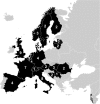Variation in neurosurgical management of traumatic brain injury: a survey in 68 centers participating in the CENTER-TBI study
- PMID: 30569224
- PMCID: PMC6407836
- DOI: 10.1007/s00701-018-3761-z
Variation in neurosurgical management of traumatic brain injury: a survey in 68 centers participating in the CENTER-TBI study
Erratum in
-
Correction to: Variation in neurosurgical management of traumatic brain injury: a survey in 68 centers participating in the CENTER-TBI study.Acta Neurochir (Wien). 2019 Mar;161(3):451-455. doi: 10.1007/s00701-019-03815-6. Acta Neurochir (Wien). 2019. PMID: 30715604 Free PMC article.
Abstract
Background: Neurosurgical management of traumatic brain injury (TBI) is challenging, with only low-quality evidence. We aimed to explore differences in neurosurgical strategies for TBI across Europe.
Methods: A survey was sent to 68 centers participating in the Collaborative European Neurotrauma Effectiveness Research in Traumatic Brain Injury (CENTER-TBI) study. The questionnaire contained 21 questions, including the decision when to operate (or not) on traumatic acute subdural hematoma (ASDH) and intracerebral hematoma (ICH), and when to perform a decompressive craniectomy (DC) in raised intracranial pressure (ICP).
Results: The survey was completed by 68 centers (100%). On average, 10 neurosurgeons work in each trauma center. In all centers, a neurosurgeon was available within 30 min. Forty percent of responders reported a thickness or volume threshold for evacuation of an ASDH. Most responders (78%) decide on a primary DC in evacuating an ASDH during the operation, when swelling is present. For ICH, 3% would perform an evacuation directly to prevent secondary deterioration and 66% only in case of clinical deterioration. Most respondents (91%) reported to consider a DC for refractory high ICP. The reported cut-off ICP for DC in refractory high ICP, however, differed: 60% uses 25 mmHg, 18% 30 mmHg, and 17% 20 mmHg. Treatment strategies varied substantially between regions, specifically for the threshold for ASDH surgery and DC for refractory raised ICP. Also within center variation was present: 31% reported variation within the hospital for inserting an ICP monitor and 43% for evacuating mass lesions.
Conclusion: Despite a homogeneous organization, considerable practice variation exists of neurosurgical strategies for TBI in Europe. These results provide an incentive for comparative effectiveness research to determine elements of effective neurosurgical care.
Keywords: Acute subdural hematoma; Neurosurgery; Practice variation; Traumatic brain injury.
Conflict of interest statement
The authors declare that they have no conflicts of interest.
All procedures performed in studies involving human participants were in accordance with ethical standards of the institutional and national research committee and with the 1964 Helsinki declaration and its later amendments.
Figures




References
-
- Bosco JLF, Silliman RA, Thwin SS, Geiger AM, Buist DSM, Prout MN, Yood MU, Haque R, Wei F, Lash TL. A most stubborn bias: no adjustment method fully resolves confounding by indication in observational studies. J Clin Epidemiol. 2010;63(1):64–74. doi: 10.1016/j.jclinepi.2009.03.001. - DOI - PMC - PubMed
-
- Bullock MR, Chesnut R, Ghajar J, Gordon D, Hartl R, Newell DW, Servadei F, Walters BC, Wilberger JE. Introduction. Neurosurgery. 2006;58(Supplement):S2–1–S2–3. doi: 10.1093/neurosurgery/58.suppl_3.S2-vi. - DOI
Publication types
MeSH terms
Grants and funding
LinkOut - more resources
Full Text Sources
Medical
Molecular Biology Databases

